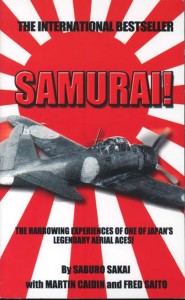Review: Samurai! by Saburo Sakai, with Martin Caidin and Fred Saito
August 20, 2012 in General Topics
 Piloting a Mitsubishi A6M “Zero” was hair-raising enough, with its notorious lack of armor and self-sealing fuel tanks, but flying one while bleeding to death, down one eye, and fading in and out of consciousness is the kind of experience Saburo Sakai, legendary Japanese fighter ace, places the reader in through his autobiography and memoir, Samurai! (with additional credit to Martin Caidin and Fred Saito), first published way back in 1957.
Piloting a Mitsubishi A6M “Zero” was hair-raising enough, with its notorious lack of armor and self-sealing fuel tanks, but flying one while bleeding to death, down one eye, and fading in and out of consciousness is the kind of experience Saburo Sakai, legendary Japanese fighter ace, places the reader in through his autobiography and memoir, Samurai! (with additional credit to Martin Caidin and Fred Saito), first published way back in 1957.
World War II is one of those conflicts shrouded in reverence, and almost mythic levels of regard, where larger-than-life change agents like Hitler, Churchill, Roosevelt and Stalin commanded implacable generals whose very names were given to colorful labels — like “The Desert Fox”, and “Old Blood and Guts”. In the shadows of these titans were regular servicemen (and women), who were often pressed into circumstances far beyond their background or expectation. The leaders in this conflict gave us history — but the soldiers gave us stories we would do well never to forget. And Saburo Sakai tells quite a story.
The book is based on interviews conducted by Fred Saito. The reader gets the impression that Sakai — known for blunt, remarkable honesty – never shied away from any potential controversy that might have resulted from his answers. It must have taken remarkable courage to be so openly bold in a time still simmering with hostility between the former Allied and Axis powers, but Sakai ratchets the provocativity even further by criticizing the war itself, and high-level leadership in the Japanese government. Yikes. And this from a man who once received a silver watch from Emperor Hirohito.
Sakai spends a surprising amount of time on his upbringing, and the many disappointments he faced early in life. He had a rough time in academia, failing to graduate High School. Seeing no other options, he enrolled in the Japanese Navy in 1933. One of Japan’s greatest aces first spent years serving as everything from a seaman to a turret gunner on a battleship. Finally getting his chance for pilot training, he graduated in 1937, at the top of his class, and here his legend began to slowly take shape, starting with combat against Communist forces over mainland China. At first, the Japanese and their planes ran rough-shod over their enemies.
At first.
When recounting dogfights, Sakai demonstrates an uncanny ability to remember every minute detail of the exact events. One senses a keen mind, relaying aircraft positions and maneuvers with almost computer-like spacial processing. Sakai has a forensics’ talent. It’s breathtaking. It shows his genius. It shows why he excelled as a fighter pilot.
The battles, though, also show the horror of warfare, especially as the United States enters the war. Sakai is placed through multiple redeployments, and he begins losing good friends and family members. One story that stuck with me from the reading was Sakai’s retelling of a bomber pilot who wished to do one loop, just one loop. Jumped by enemy fighters, Sakai watches as one of the bombers he is escorting, already on fire and doomed, attempts an impossible loop – and explodes when it goes vertical.
Never once does Sakai spare his matter-of-fact, honest memories of witnessing tragic, painful deaths, or returning to base to find dear friends gone. He often remarks on what strikes him as a strange, otherworldly calm he senses when returning home on leave, stunned at how the civilians are so unaware of what’s going on elsewhere.
The desperation in the Pacific reaches an apex when Sakai is nearly shot down, and flies his battered “Zeke” back to friendly shores, in a harrowing voyage that ends almost miraculously with his return to base. Sakai then endures eye surgery without anesthetic, something agonizingly described in the book, and returns to combat as an ace with one good eye, in time to face swarms of American planes as part of a hand-picked elite squadron.
He goes on to lament the too-little, too-late arrival of new fighter models, one in which the squadron achieves great success against allied aviators, and recalls the end of the war and the soul-crushing finality that gripped his unit. In a stark example of command violation, Sakai and his comrades take to the air over a surrendered Japan just to attack bombers — just to make a statement, if only to themselves.
In his later years, Sakai would come out against the kamikaze tactic, openly criticize Imperial Japan’s wartime leadership, and become a pacifist that prayed unceasingly for those he shot down. He died in 2000. Sakai, like many fighting the terrible Second World War, was a decent man trapped in titanic times. His frustration is palpable in this book, particularly after his wounding, but so is his courage, dignity and decency — worthy of his Samurai lineage, indeed.
4/5 stars.
Stay tuned.
Click here to enjoy more reviews.

Recent Discussion